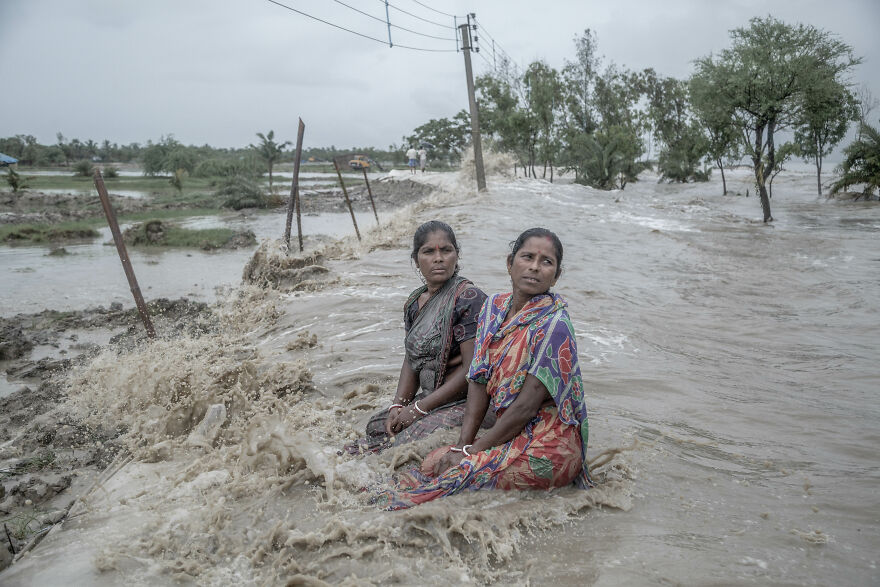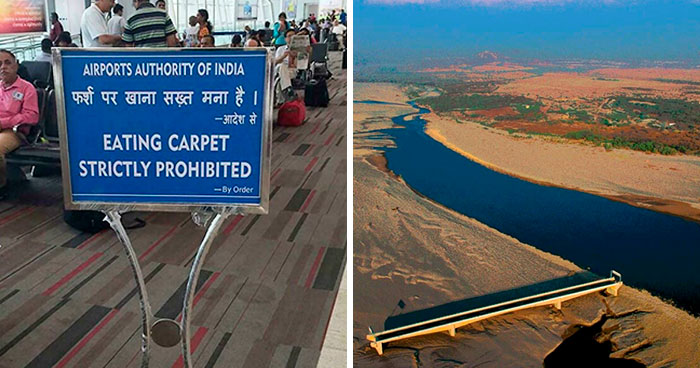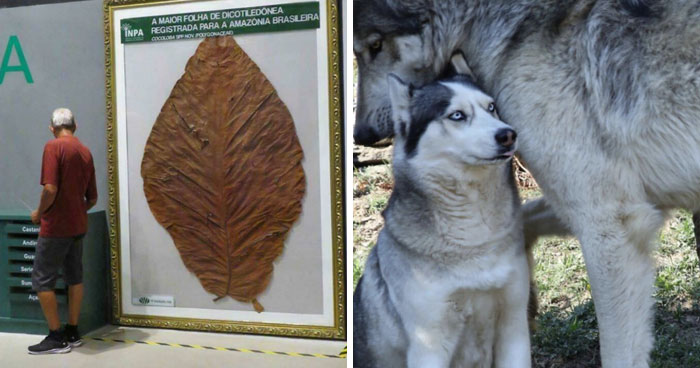
42 Eye-Opening Winning Images Of The 2024 Mangrove Photography Awards
InterviewFor the 10th year in a row, The Mangrove Photography Awards, hosted by the Mangrove Action Project, are spreading awareness about mangroves' importance to various species and to us humans as well.
"Every year, we’re inspired by the incredible submissions, which help raise awareness of the people and wildlife that rely on mangrove forests, the threats they face, and why urgent action is needed to protect them," wrote the organizers on their site.
So today, we would like to present you with this year's winners, runner-ups, and highly commended entries. Hopefully, these photos will inspire you to learn more about mangroves and their importance to our world and maybe even try to help preserve them.
Take a look at the winners of 2023. And here are the People's Choice Awards, where people can vote for their favorite mangrove photo on Instagram.
More info: photography.mangroveactionproject.org | Instagram | Facebook | Instagram
This post may include affiliate links.
"Friends At The Edge" By Jillian Morris, Bahamas
Mangroves and Underwater category, Highly Commended.
Jillian Morris spies two juvenile lemon sharks in the Bahamas
“These juvenile lemon sharks were cruising in a deeper pocket at the edge of the mangrove forest. They can still seek refuge but are spending more time away from the nursery habitat as they get older and bigger.
“This species is also social, especially when they are young. They are often seen seeking refuge, hunting, or resting together.”
To learn more about the photography awards, Bored Panda reached out to Leo Thom, a creative director at Mangrove Action Project, and Supratim Bhattacharjee, the overall winner of this year’s competition.
First of all, Thom shared his fascination with the winning image by Supratim.
“This year’s winning image is so powerful. We see a girl’s life turn upside down after a cyclone, her teahouse drowning in the background. Her look of helplessness, reflecting the turmoil of life for many people on the coastlines of the Sundarbans in India. The whole village was entirely flooded by the sea and this girl and her family had to move away to build a new home. It’s a common problem in the area where extreme weather events have meant seawater breaches the protective embankments, their land becomes inundated with saltwater from the sea, making it impossible to grow crops, on which they rely for food.
Although devastating, there is a bit of good news for the girl. I did hear that the photographer returned to the same region this past week and found the girl and the family surviving well at the new home they built.”
"Framing The Sunset" By Vladimir Borzykin, India
Mangroves and Landscape category, Highly Commended.
Vladimir Borzykin frames picturesque mangrove trees during a colourful sunset on the Andaman islands.
“Behind the beauty of white sand beaches and coconut palm trees, the rugged coast of Neil island (Shaheed Dweep) in Andaman islands archipelago, studded with picturesque mangrove trees, is largely overlooked.
The sea around the island being very shallow, the tide recedes far away from the shore exposing an extremely sharp rocky reef. After a week of 'dancing' around this particular set of mangroves, trying different photo compositions and, luckily, having low tide and sunset timing coincide, I came up with this shot that captures the essence and atmosphere of the place and moment.”
"Kakaban Mangrove" By Purwanto Nugroho, Indonesia
Mangroves and Underwater category, Highly Commended.
Purwanto Nugroho captures the charm and power of underwater mangrove habitats.
“Mangroves act as a natural filter that can remove most pollutants before they reach the ocean. Soil and mangrove biomass have a significant capacity to store carbon from the atmosphere, helping to reduce carbon dioxide concentrations in the air.
“The complex roots of mangroves help bind soil and sediment, reduce erosion, and protect against damage due to waves or currents. Thus, mangrove conservation efforts are crucial to maintaining environmental sustainability and human life."
Supratim shared the backstory of his image:
“The award-winning photo was captured during the complete COVID-19 lockdown on a cyclonic day. I was staying at a hotel in Bakkhali, documenting the devastating impact of cyclonic weather on a full moon day, a project I’ve pursued for nearly two decades in the Sundarbans region.
The night before the photo was taken, I planned a visit to Lakkhipur village with my friend Goutam. Fraserganj, where the picture was taken, lacks embankments, making it particularly vulnerable. I arrived early in the morning and witnessed the overwhelming force of the high tides. The residents of Lakkhipur, located on Frazerganj, were frantically trying to save their belongings from the encroaching sea water.
Among them was 11-year-old Pallavi, whose house, including a tea shop, had been completely submerged the previous night. Her composed demeanor and resilient expression amid the chaos compelled me to capture her photograph, showcasing her strength in the face of such devastation.
Speaking with Pallavi, she shared how the relentless sea waves are slowly eroding their future year after year.”
"Jungle Cat" By Erfan Samanfar, Iran
Mangroves and Wildlife category, Highly Commended.
A forest cat after hunting in the mangrove forest of Bandar Abbas, Iran
The jungle cat, also called the reed cat or swamp cat, is an endangered species in Iran. The solitary species are expert nocturnal predators with a taste for rodents, fish, and small birds.
“One autumn day, I had gone to the mangrove forest to photograph birds, when I suddenly saw this cat. Even the locals rarely see this cat, and I feel very lucky to be able to photograph this forest cat.”
"Tapa Cara" By Sebastián Calle, Colombia
Mangroves and Wildlife category, Highly Commended.
Sebastián Calle has an unexpected encounter while birdwatching in the mangroves of Punta Soldado.
“The silky anteater (Cyclops dorsalis) is a recently described species, quite difficult to find due to its size and low populations, which are increasingly threatened by habitat deforestation.
“While searching for better angles in the mangrove mud to photograph some orioles, I came across this small anteater. I had little information about the species, its behavior, and its vulnerability, so I took the photos with a telephoto lens and encouraged the local community participating in a bird monitoring program to care for it, understand its importance, and protect its habitat.”
Supratim also shared what are some of the most pressing threats to mangrove forests that he has personally witnessed.
“Growing up, I frequently visited my maternal grandparents' home in Canning, near the Sundarbans. I fondly remember the lush greenery and playing under the expansive, shady trees during scorching summer afternoons. However, nearly 28-30 years later, the landscape has dramatically changed. The indiscriminate cutting down of trees has transformed the area, and many islands in the Sundarbans, once teeming with Sundari trees and mangrove forests, have lost their verdant charm.
The large trees that once acted as buffers against soil erosion from tidal floods are now gone, making floods and cyclonic attacks increasingly common. Several islands have already submerged, and many more are at risk.
Climate change has dramatically altered our environment over the past few decades. In the Sundarbans, I have personally witnessed the drastic transformation of the landscape due to global warming and frequent cyclones. Rising sea levels, driven by global warming, have led to increasingly severe flooding from violent storm surges. Many islands have already submerged, and predictions suggest that a significant portion of the Sundarbans will be underwater in the coming years. If this trend continues, even Kolkata could face flooding.”
"Sinking Sundarbans" By Supratim Bhattacharjee, India
Mangrove Photographer of the Year, Overall Winner.
Supratim Bhattacharjee witnesses a girl, standing before her tea shop, which is completely ruined by sea water in Frazerganj, Sundarbans.
“After Cyclone Aila struck the Sundarbans in 2009, it became clear that frequent cyclonic events will turn the residents of the Sundarbans into climate refugees. Between May 2019 and May 2021, the Sundarbans faced four cyclones – Fani, Bulbul, Amphan, and Yaas – each devastating enough to justify the fear of mass displacement.”
“An image that raises a thousand questions, whilst connecting you to the girl’s heart. Her vulnerability exposes the full impact of climate change and sea level rise experienced by many coastal communities”, says judge Dhritiman.
Nestled in the Bay of Bengal, the Sundarbans is the largest mangrove forest in the world – and one of the most vulnerable. Once lauded as nature's custodians, these mangroves now endure relentless threats driven by human development and the climate crisis.
Rampant deforestation has compromised its role in climate regulation, exacerbating soil erosion and leaving vast stretches vulnerable to encroaching waters, particularly during cyclonic disturbances.
"Morelet's Reflection" By Shane Gross, Mexico
Mangroves and Underwater category, Highly Commended.
Shane Gross frames a Morelet’s crocodile, king of the mangroves.
“I was snorkeling in a beautiful mangrove lagoon when this Morelet's crocodile decided he was warm enough and entered the water from his favorite sunbathing rock.”
Also known as the Mexican crocodile or Belize crocodile, Morelet’s are found exclusively in the Atlantic regions of Mexico, Brazil, and Guatemala.
There are thought to be 79,000 to 100,000 individuals living across marine coastal and wetland habitats.
“Adding to the crisis is the reckless deforestation of mangrove forests. Many island residents are unaware of the long-term consequences of this destruction. Deforestation is erasing natural habitats and diminishing the region's green aura. The natural barriers that once protected the land from floods are being systematically destroyed.
Through my photography, I aim to raise awareness about climate change in the Sundarbans and its impact on the lives of children in the region. I am capturing the faces of climate change victims to send a powerful message: it is time to take action on fossil fuels, the primary driver of rising global temperatures. The consequences—droughts, wildfires, sea level rise, disease, and migration—are already here, and we must act now to mitigate further damage.”
"Mangrove At Night" By Nicholas Alexander Hess, Australia
Young Mangrove Photographer of the Year, Winner.
An in-camera multiple exposure image of elements of the mangrove captured in the dark.
"Equipped only with my macro lens, I wanted to capture more than just this young saltwater crocodile when I encountered it at low tide in the mangroves.
“I used the multiple exposure mode in my camera to superimpose layers onto my image of the croc's eye to capture more of the scene without sacrificing detail of the eye.
“Captured at night, the image gives off a slightly unsettling feeling, such as what one may experience in a mangrove, unknowing of what predators may be lurking nearby, hidden by the dense network of the mangrove."
Nature And Space By Jeff Thamert, USA
Mangroves and Threats category, Runner Up.
Jeff Thamert records a rocket launch above Florida’s mangroves.
“This was shot near the SpaceX launch facility where launches are happening far too often, which has already had some negative effects on The Indian River Lagoon and sanctuary. We have seen the decline of water quality and sea grasses, which has affected sea life, plants, and animals.”
“Climate Change in Indian Sundarbans:
Located in the embrace of the Bay of Bengal, the Sundarbans archipelago straddles the borders of India and Bangladesh, with India claiming a significant 40% of its vast expanse, encompassing roughly 10,000 square kilometers. Celebrated as the planet's largest mangrove forest, the Sundarbans hosts a collection of 102 deltaic islands within the Indian territory, of which 52 are inhabited. Serving as a natural shield against the fury of storm surges and cyclones, this ecological marvel stands as an invaluable asset. However, relentless exploitation for economic gain has unleashed a cascade of detrimental consequences, including rampant deforestation, erosion of soil, and a compromised capacity for climate change mitigation.
In recent years, substantial portions of the Sundarbans have fallen prey to encroaching waters, rendering them increasingly susceptible to the wrath of cyclones, torrential rains, and storm surges. The period spanning from 2019 to 2024 witnessed a barrage of cyclones—Fani, Amphan, Bulbul, Yaas, and Remal—further destabilizing the Indian Sundarbans. Concurrently, the forces of urbanization and modernization have aggravated these challenges, exacerbating the significant loss of mangroves due to soil erosion. Over the past five decades, studies conducted between 1975 and 2020 have documented a steady decline in mangrove density, with an annual decrease estimated at 1.3%.”
"Guardians Of The Gulf" By Nick Conzone, USA
Mangroves and Underwater category, Runner Up.
Nick Conzone captures the moment a Diamondback terrapin emerges from its underground burrow in the Gulf Coast of Florida's mangrove islands.
“The diamondback terrapin is a keystone species, crucial for defending mangroves from snails, crabs, clams, and small fish. By keeping these populations in check, these turtles prevent overgrazing that could damage the mangroves and disrupt the ecosystem.
“They are well-adapted to their habitat, navigating underwater root systems with agility. Their webbed feet and strong beaks enable them to hunt effectively, ensuring the health of the mangrove forests by maintaining balanced prey populations.
“In the black mangrove islands, terrapins make their homes in shallow burrows dug into the soft mud. These burrows provide protection and a vantage point for watching their surroundings. Without mangroves, terrapins would be forced to live closer to shore, facing greater risks from human interaction, pollution, and habitat destruction.”
"Spectacular Mangrove Symphony" By Ammar Alsayed Ahmed, United Arab Emirates
Mangroves and Landscape category, Highly Commended.
A breathtaking coastal panorama in Abu Dhabi reveals a mesmerising play of colours.
“Abu Dhabi's diverse ecosystem, teeming with marine life, is adorned by resilient mangrove trees. Renowned for their exceptional salinity resistance, these trees feature aerial roots that emerge as slender columns allowing for respiration.
“Beyond their ecological significance, mangrove swamps actively contribute to reducing air pollution and mitigating the effects of climate change by absorbing greenhouse gases.”
“The ingress of tides has exacerbated existing adversities, intensifying food and water scarcity, diminishing agricultural yields, and degrading arable land. The COVID-19 pandemic and ensuing lockdowns delivered severe blows to local livelihoods, triggering widespread unemployment particularly among migrant laborers, who suddenly found themselves bereft of income and support.
The devastating aftermath of cyclones like Amphan and Yaas has left many residents destitute and homeless, underscoring the critical importance of mangrove conservation in averting such catastrophes.
Alarming statistics reveal that 52 out of the 102 inhabited islands in the Indian Sundarbans are sinking at an alarming rate. Since 1967, the Sundarbans has contracted by 210 square kilometers, and since 1904, by a staggering 451 square kilometers, resulting in island inundation. The foremost concern centers on the widespread displacement stemming from land loss. Empirical evidence and forecasts underscore the acute vulnerability of the delta region, with segments of Mousuni and Ghoramara Islands already submerged. The Sundarbans teeters on the precipice of what could potentially become one of the largest human migrations in history, with Kolkata looming as the next probable destination,” Supratim explained the threats.
"Mud-Ring Feeding" By Mark Ian Cook, USA
Mangroves and Wildlife, Winner.
Restoration scientist and photographer Mark Cook witnesses a bottlenose dolphin grabbing a mullet from the air during ‘mud-ring feeding’.
“Mud-ring feeding is a rare and unique fishing behavior employed by bottlenose dolphins living solely in the shallows of the mangrove-lined bays of Florida Bay and just a few other locations in the Caribbean.
“On finding a school of mullet, a single dolphin from the pod encircles the fish kicking up the sediments with its tail, which effectively corrals the fish into an ever-tightening spiral-shaped silty plume. The fish don’t like to be trapped or swim through the sediments, so they typically try to jump out of the water and over the “net” to freedom.
“Unfortunately for the fish, the dolphins have a remarkable capacity to know where the fish are going to jump and will snatch them from the air as they try to make their escape. The ability to strategize and coordinate such a hunt, as well as the ability to share equally, is a testament to the incredible intelligence of these animals.”
"Sawfish Sunrise" By Grace Pempek, USA
Mangroves and Underwater category, Highly Commended.
Grace Pempek observes a critically endangered juvenile smalltooth sawfish in the mangrove shallows at sunrise.
"If there is one thing I have learned in underwater photography, it is to always be ready, as you never know what the ocean will present to you—nor when. Luckily, that was the case for me when I encountered a juvenile smalltooth sawfish in the Florida Keys. I knew I had to make the most of my chance encounter with this bucket-list species—truly a once-in-a-lifetime opportunity!
“I was fortunate it seemed relaxed in my presence without any other beachgoers in the water. However, as more and more people came to the beach to watch the sunrise and enjoy their morning coffee, I slowly backed off the subject, not wanting to draw too much attention to this very rare and endangered animal.”
Such a beautifully odd sawfish! Thankful that he didn’t reveal what he was filming!
The photographer also shared what message he hoped for the viewers to take away from his photo.
“Sundarbans is always my second hometown, as I have mentioned. I have covered almost each and every cyclone over there. During cyclones, the experience I got is unforgettable. I see people are moving everywhere for shelter, their home is being swept away by storm surges, their suffering to collect drinking water. I feel bad for the children of Sundarbans because they really do not deserve it in between the environmental turbulence. Their books, documents are being swept away each and every cyclone. So, there is no specific experience to be mentioned.
I was born in South 24 Parganas and raised here, which is the most vulnerable district to super cyclones. So, I never faced any difficulties while working in my region. I have been among super cyclones several times to capture disasters and this journey will be continuing until the situation is restored a bit.
Photography is a powerful tool that illustrates the reality and its impact on human and animal life. My long-term raw photographs capture the momentary disasters of various places, revealing the actual scenarios and the hardships the people endure. Policymakers can easily discern the helplessness of human life through these frames.”
"Piangua, Vital" By Daniel Alvarez, Colombia
Mangroves and People category, Highly Commended.
Daniel Alvarez sheds light on the work of minorities in the peripheral regions of Colombia.
“In the peripheral regions of Colombia, the daily struggle for sustenance coexists with a rich cultural heritage and a deep-rooted connection to the land.
Aura Nelly – known as 'La Ñata' – and Gabriela, two piangua harvesters from La Plata in Bahía Málaga, Valle del Cauca, work meticulously in the mangroves, collecting mangrove cockle or 'piangua'.
“These cockles are a source of livelihood as well as living testimony to the interdependence between human beings and nature. Every gesture, every verse sung while they work, reflects the profound connection with the land and sea that surrounds them as well as the determination to preserve their cultural roots in an ever-changing world.”
“I consider photography a medium that can achieve what several articles cannot. By choosing long-term projects, I often visit the same place twice a month to ensure I depict the struggles of human life facing water crises, environmental disasters, poverty, and more. Through my pictures, I aim to present visual evidence of our blue planet's condition. I plan to showcase comparative images to highlight changes in specific places over 5-10 years, making it easier for conscious individuals and environmentalists to see the differences. Additionally, I strive to illuminate how future generations may be deprived of certain natural delights that we were fortunate to enjoy.
Consequently, active control measures should be taken by the government, knowledgeable citizens, and environmental workers to mitigate impending damages. While we can draw borders between states and nations to check illegal immigrants, we cannot draw a border in the air to prevent pollution from spreading. Hence, there is an immediate need to conserve our environment to make it a better living place for future generations.
Each of my pictures is unique, capturing a fraction of a second with far-reaching implications.
Through my work, I want to convey the fierceness of our beautiful environment and the urgent need for rapid action before we lose it forever. I hope my selection of photographs will help people understand the injuries we, as human beings, have inflicted on nature and how it is now retaliating,” wrote Supratim.
"Mud Bath Ritual" By Johannes Panji Christo, Indonesia
Mangroves and People category, Winner. Johannes Panji Christo watches as a local Balinese man is covered in mud during a bathing tradition, locally known as Mebuug Buugan. “Men, women and children, wearing sarongs and traditional headgear, collect mud from a mangrove forest in Kedonganan village, just outside the town of Denpasar, and cover themselves as part of a purification ritual. Mebuug Buugan was recently revived after a 60-year hiatus. Hosted the day after the annual “Day of Silence Festival”, in which people stay home and self-reflect, the ritual sees people pray for gratitude and earth’s fertility.
"David vs. Goliath" By Abhishek Das, India
Mangroves and Wildlife category, Highly Commended.
Abhishek Das spies a delicate mudskipper perched boldly on the tail of a massive crocodile.
“Is the mudskipper really the David? Tiny yet fearless, it contrasts sharply with the powerful, armoured crocodile, highlighting the stark difference in their sizes and the audacity of the smaller creature. Meanwhile, the crocodile’s tail resembles the numerous fights it has been through.”
There is no doubt that photographing and sharing the stories behind mangroves is extra important. Therefore, we were curious what advice Leo Thom would give to aspiring photographers who aim to capture the essence of mangrove ecosystems and make their work stand out in future competitions.
“I think like any hobby or discipline, the more you practice, the better you get at it. And in the same way, the more you understand your subject which you are photographing, the better you will be able to capture what it is that you are seeing and want the viewer to see. So, my advice is to spend time within the mangroves; understand the tides, the dynamics, and how people or wildlife you are interested in are interacting with it. It’s fascinating and you will start to see the magic hidden within these ecosystems.”
"Honey Heist" By Upamanyu Chakraborty, India
Mangroves and People category, Highly Commended.
In the Sundarbans, the Mawli embark on the dangerous operation to harvest rare mangrove honey.
“In the heart of the Sundarbans, as spring turns to early summer, these brave honey collectors embark on 'Operation Golden Honey,' sanctioned by the forest department. Their goal is the rare mangrove honey, celebrated for its unique flavor and medicinal properties.
“Wearing masks on the backs of their heads to deter tiger attacks, they spend two weeks living aboard hand-driven boats, navigating narrow channels amid threats from increasing storms due to climate change.
“This honey, rich in flavor and medicinal properties, is sold to the forest department, providing vital income. The Mawli's sustainable practices ensure the honey harvest does not deplete bee populations or harm the environment, allowing the forest to thrive year after year.”
"In Search Of Drinking Water" By Dipayan Bose, India
Mangroves and Threats category, Highly Commended.
Dipayan Bose witnesses a woman carrying a pot of drinking water surrounded by rising seawater in the Sundarbans, West Bengal.
“Due to repeated tropical cyclones and sea level rise in the Bay of Bengal, river embankments have broken and villages submerged. Farmlands and fisheries have been destroyed, and people are forced to take shelter in the upper lands, leaving their ancestral properties.
“Numerous diseases are now prevalent in these areas due to toxic water, malnutrition, and lack of proper medical support.”
Supratim also shared his advice to photographers passionate about environmental conservation.
“If you aspire to become an environmental conservationist through photography, passion for the environment is essential. You must possess in-depth knowledge of the regions where you work and build strong connections with climate-vulnerable communities. Remember, a photograph's beauty alone is not enough; it must also be powerful. Only then can it create a significant impact on global audiences and prompt policymakers to take action for the betterment of humanity.”
"Together" By Raj Hassanaly, Madagascar
Mangroves and Conservation Stories category, Runner Up.
Raj Hassanaly records restoration efforts by Anosikabija, a rural commune in Majunga, Madagascar.
“Bôndy, a private company working in ecosystem restoration, collaborates hand in hand with local communities to restore mangroves.
"The local communities realize that with the cutting of mangrove trees, it is becoming increasingly difficult to fish, catch crabs, or simply protect themselves from climate change and increasingly violent cyclones in these regions. Together, always with a smile and in good spirits, they traverse the mangroves to revive vast stretches of isolated land."
Sinking Sundarbans II By Supratim Bhattacharjee, India
Mangroves and People category, Highly Commended.
Two women helplessly watch sea waves reclaim their homes in the Sundarbans.
The Sundarbans archipelago spans the borders of India and Bangladesh, with India laying claim to 40% of its approximately 40,000 square kilometers. The area is known for its rich forest resources, which locals rely on for income.
But rampant deforestation coupled with worsening storms has intensified food and water scarcity, diminished agriculture productivity and soil quality, and turned local communities into climate refugees.
“The COVID-19 pandemic and ensuing lockdowns delivered a severe blow to local livelihoods, especially for migrant laborers who found themselves without income or support. Cyclones like Amphan and Yaas inflicted significant damage, leaving many without sustenance or shelter.
“Adequate preservation of mangroves could have mitigated the catastrophic toll of these events. The Sundarbans face the prospect of witnessing one of the largest human migrations in history, with Kolkata at risk of submersion.
Regarding technological advancements in photography, we asked Leo Thom to share his view of these tools helping photographers better capture and convey the critical importance of mangrove ecosystems.
Leo wrote: “With better cameras in different shapes and sizes becoming more available to everyone, you can really see the increase in diversity and quality looking through the last 10 years of the photography awards. I’d say we receive so many more drone aerial photos now than we used to, camera-trap photos and underwater. I think it’s brilliant to utilise these new technologies, especially as mangroves are tough environments to work in. Of course, these tools bring new perspectives also, and it can give us new insights into the importance of mangroves within the bigger ecosystem. When flying drones, do be careful about the impact it can have on birdlife.”
"Guardians Of The Bay" By Jake Mason, Australia
Mangroves and Landscape category, Highly Commended.
A cluster of mangrove trees at the water’s edge guard the coastline, protecting against erosion and providing habitat for countless species.
“During our exploration, these mangroves, positioned at the forefront of Faure Island, stood out as natural defenders against coastal erosion.
“This photograph captures their dense roots and lush foliage at dusk, with the calm seas and fading light creating a tranquil yet powerful scene. The image underscores the importance of these ecosystems in maintaining coastal integrity and supporting marine life.”
"Symbiosis" By Giacomo D'orlando, Indonesia
Mangroves and Conservation Stories category, Winner.
Giacomo d’Orlando portrays life in one of the most vulnerable places to climate change.
"In Demak Regency, a combination of human induced activities and the increasing pressure brought by climate change are threatening coastal communities. The coastline has been severely eroded, and mangroves that once protected the coast have been cut down and replaced by aquaculture ponds. As a result, the sea is literally swallowing people’s homes.
“Despite the difficult living conditions, most of Demak's residents don't want to move because their income potential is tied to their location near the sea. Over time, though, they have realised that the only solution is to restore the ecosystem by replanting the mangroves that had been cut down.
“A government policy based on mangrove transplantation, together with a reduction in groundwater extraction, could be the only way to ensure a future for the local coastal communities."
As the Mangrove Photography Awards continue to grow, Leo shared his aspirations for the future of this competition:
“I mentioned above we are seeing so many aerial photographs, perhaps that should be a new category next year. We are also about to launch our first People’s Choice Award, a selection of 9 awesome images from this year’s submissions, which will run for one week. Please check it out and vote for your favorite and have a chance to win a signed print. Check it out on our Instagram.
Our bigger aim for the project is that the awards inspires and catalyses conservation and restoration efforts of our mangrove ecosystems. We’re working hard with partners to keep raising awareness of mangroves, but in the end, we want it to directly lead to impact on the ground. So we’re looking to combine the storytelling world with the conservation and restoration world, ensuring the health of mangroves for generations to come.”
"Satellite-Tagged Rewilding Hope" By Upamanyu Chakraborty, India
Mangroves and People category, Runner Up.
Upamanyu Chakraborty captures a Northern River terrapin (Batagur baska) before release as part of a conservation breeding program and rewilding in the Sundarbans.
“After a possible local extinction from the mangroves of Odisa, the estuaries of the Sundarbans are now the last resort of this brackish water-dwelling four-toed terrapin, thanks to relentless poaching for meat and harvesting eggs.
“However, a conservation breeding program was started in 2012 with a very small existing founder population from a village pond. Presently, this comprehensive program has reached a milestone. With blessings from 'Bonbibi', a deity worshipped by both Hindus and Muslims, who protect them from 'Dakshinray', the incarnation of Bengal Tigers, a successful rewilding program into the natural habitat of some sub-adult individuals with 'Satellite tags' was done in January 2022, along with a robust post-release monitoring program.
“By collecting the inputs from this pilot reintroduction, the hope is to bring back a viable population in the natural habitat of the Sundarbans.”
"Guardians Of The Mangroves" By Olivier Clement, Bahamas
Mangroves and Underwater category, Winner.
Olivier Clement offers a glimpse into the intricate world of mangrove roots in the Bahamas. Judge Christian Zielger enjoyed the use of the mangrove roots as a captivating ‘frame’. “It evokes a sense of calm and peace”, he says.
“A turtle gracefully navigates the mangroves’ labyrinthine roots at high tide, seeking refuge for the night. At high tide, the water rises, engulfing the roots and transforming this space into a haven for marine life seeking shelter and safety.
“The turtle's journey is a poignant reminder of the vital role these ecosystems play in sustaining marine biodiversity. As the day fades into dusk, the turtle's search for a safe resting place reflects the delicate balance of life within the mangroves, highlighting the urgent need for conservation to ensure the survival of these invaluable habitats for generations to come.”
Lastly, Leo added: “Just to say come and follow us across social and get involved if you are into photography or the environment.
The Mangrove Photography Awards is brought to you by Mangrove Action Project (MAP), a US-based non-profit whose mission is to empower communities worldwide to conserve, manage, and restore mangrove forests. Through science, training, and environmental education, they provide nature-based solutions for people and our planet.”
"The Fire Within" By Javier Orozco, Mexico
Mangroves and Wildlife category, Highly Commended.
Javier Orozco comes face to face with a crocodile at El Cora Crocodile Sanctuary in Bucerias in the State of Nayarit, Mexico.
“In the last 40 years, Banderas Bay has lost more than 80% of its wetlands to urban expansion. Crocodiles and other species continue to survive, now surrounded by busy highways, hotels, and condominiums.
“This crocodile sanctuary is a non-profit organization located next to a small lagoon. The surrounding area has been taken over by shopping centers, hotels, and condos and the biggest threat has been the "Flamingos" developers. Corrupt politicians have sold Federal and non-Federal land that has fragmented the remaining wetlands.”
"Mangroves On Tidal Flats" By Stuart Chape, Australia
Mangroves and Landscape category, Highly Commended.
Mangrove forests grow along creek lines on the tidal flats of Kakadu National Park.
Stuart Chape captured this shot from a helicopter in Australia’s Northern Territory. Mangroves are a significant ecosystem in the park’s coastal zone, which is only accessible by boat or air. Here, mangroves not only provide coastal protection but are also high in biodiversity and provide an important resource for Aboriginal people.
"The Last Mangrove" By Roun Ry, Cambodia
Mangroves and People category, Highly Commended.
Trapeang Sangkae Fishing Community Members help a group of locals to replant mangrove trees in Kampot, Cambodia.
“Bôndy, a private company working in ecosystem restoration, collaborates hand in hand with local communities to restore mangroves.
“The local communities realize that with the cutting of mangrove trees, it is becoming increasingly difficult to fish, catch crabs, or simply protect themselves from climate change and increasingly violent cyclones in these regions. Together, always with a smile and in good spirits, they traverse the mangroves to revive vast stretches of isolated land.”
"Foggy Fusion" By Ammar Alsayed Ahmed, United Arab Emirates
Mangroves and Landscape category, Highly Commended.
Ammar Alsayed Ahmed captures a magical moment as dawn fog sweeps over the urban mangroves of Al Reem Island in Abu Dhabi.
The UAE’s coastline features 155 square kilometers of mangrove trees, known locally as Qurm. In the past, local communities heavily relied on qurm as a source of food, fuel, and for building ships and houses.
Across the country’s seven emirates, 13 important mangrove sites nestle along the coastline, including Al Hafiya in Khor Kalba, Sharjah, a Ramsar site of international importance.
"Citrus Serenity" By Olivier Clement, Bahamas
Mangroves and Underwater category, Highly Commended.
Olivier Clement witnesses the grace of a lemon shark navigating the intricate mangrove maze beneath the Bahamas’ tranquil waters.
"As I waded through the shallow waters, camera in hand, I stumbled upon a breathtaking scene: a lemon shark gracefully gliding through the maze, its sleek form contrasting against the verdant backdrop of the mangroves.
“With every movement, the shark seemed to dance among the roots, a testament to the harmony between predator and habitat. The lemon shark, about a foot long, exuded a sense of tranquillity as it navigated the channels, its presence a reminder of the delicate balance within this thriving ecosystem.
“Capturing this moment was a privilege, a glimpse into the hidden wonders of the natural world and a testament to the importance of preserving such sanctuaries for generations to come."
"Roots And Refuge" By Mark Kevin Badayos, Philippines
Mangroves and Landscape category, Highly Commended.
This captivating image illustrates the role of mangrove roots in protecting and stabilizing shorelines. All sorts of diverse marine life are adapted to survive in the coastal habitats.
“Among the intricate roots of the mangroves, a solitary hermit crab stands guard, symbolizing the delicate balance of our coastal ecosystems.”
"Moonlit Shadow" By Wyatt Albert, Bahamas
Mangroves and Underwater category, Highly Commended.
Wyatt Albert calmly captures a youngster appearing out of the darkness
“The security of mangroves in the night allows juvenile lemon sharks to swim under their branches to hide their moonlit shadows from lurking predators.
"Exhibiting dilated pupils along with utilising the maze created by Black mangrove (Avicenna germinans) peg roots, they are able to either capture their prey or evade their larger predators in the darkness."
"Sian Kaan’s Orange Carpet" By Santiago Gibert Isern, Mexico
Mangroves and Landscape category, Runner Up.
Santiago Gibert Isern captures the unique patterns of the Sian Ka'an Biosphere Reserve in Quintana Roo in Mexico’s Yucatan Peninsula.
During a series of flights to document the reserve’s conservation status at the beginning of the rainy season, the conservation photographer and storyteller noticed the intense colors below.
“I asked the pilot if we could make some circles over the lagoon to capture one of the most characteristic processes of the mangroves, the decomposition of the dead leaves that dye the water with their tannins and at the same time nourish such an important ecosystem. The result was an artistic impression where two powerful colors are combined: green and orange — the first one represents life in all its splendor and the second one the regeneration of life.”
"Mangrove Walls Broken" By Dipayan Bose, India
Mangroves and Threats category, Winner.
Dipayan Bose frames a villager standing inside his half-submerged home during a flood.
Due to repeated tropical cyclones and sea level rise in the Bay of Bengal, river embankments have become broken by high tides in coastal villages across the Sundarbans, West Bengal. As a result, homes and farms have flooded, fisheries have become destroyed by seawater, and people have been forced to migrate, victims of climate change.
“This villager has lost all his household belongings in the flood. The cutting down of trees for commercial and domestic use has made the area prone to natural disasters. Storms, heavy rainfall, and floods wreak havoc here. Approximately 3.14mm rise in sea levels every year has taken several islands under the sea. Increased soil erosion and loss of soil quality resulting in reduced crop yield have made situations worse.”
"Nature's Ribbon" By Ammar Alsayed Ahmed, United Arab Emirates
Mangroves and Landscape category, Winner.
In nature's embrace, a sinuous water channel meanders gracefully, flanked by a verdant gallery of mangrove trees lining its edges, in Al Dhafra Region, Abu Dhabi.
“This tranquil scene invites contemplation as the gentle flow of water navigates its course through the heart of the mangrove forest.
“The intertwining roots of the trees form intricate patterns, creating a natural tapestry that harmonises with the fluidity of the water. In this tranquil oasis, the photograph captures the timeless beauty and serenity of a landscape shaped by the delicate dance of water and mangroves.”
"The Hippo And The Yellow Fly" By Nele Holstegge, Gambia
Mangroves and Wildlife category, Highly Commended.
Nele Holstegge captures a hippo peeking out of the water of the river Gambie.
“We were driving past the mangroves that line the shores of the river Gambie looking for chimpanzees when I suddenly saw two big eyes peeking out of the water just 2-3 meters away from the boat.
“I was amazed at how inconspicuous an animal of this size could be, as I had never seen one before. I only recognized the fly next to its eye when I was editing the photo afterwards.”
"Mudskipper In Aurora" By Jayanta Guha, India
Mangroves and Wildlife category, Runner Up.
“Jayanta transports us into a dreamlike painting with the mudskipper, among the tall colorful grasses.”, says judge Christian Zielger.
Mudskippers are actually a species of fish found in mangroves and mudflats. Spending most of their time out of the water, they’re adapted to remain on land even after the tide has gone out. They mostly breathe by holding water in their mouth and gill chamber, though staying damp also allows them to breathe through their skin.
Their large eyes make them excellent predators while their pectoral fins act as legs, allowing them to crawl over mud and trees along the mangrove floor.
"Human Hunger" By Star Udyawar, India
Mangroves and Threats category, Highly Commended.
Star Udyawar highlights how widespread urban development has encroached on mangrove habitats.
“Towering buildings and cleared land serve as a stark contrast against the delicate and biodiverse mangrove forests. The encroachment represents a profound threat to the environment, as these vital coastal habitats are being rapidly diminished by widespread development and clearing.
“Hundreds of hectares of mangroves are cleared to make room for these industries. But that is not the end of the problem. These industries typically release effluents into the nearby ponds on several occasions, creating an impervious physical and toxic oily layer.”
"Mangrove Coast" By Balazs Fodor, Indonesia
Mangroves and Landscape category, Highly Commended.
Balazs Fodor captures an aerial view of seaweed farms along a mangrove coast in Nusa Lembongan, Indonesia.
“Seaweed farming in Nusa Lembongan has been a significant economic activity for local communities for decades. The shallow, nutrient-rich waters of this small island provide an ideal environment for seaweed cultivation.
“In regions like Nusa Lembongan, where mangrove forests fringe the coastline, integrating seaweed farming with mangrove conservation can yield multiple benefits. Seaweed can only thrive in a healthy environment, so seaweed farmers keep beaches and shorelines clean, thereby further enhancing local biodiversity.”
"The Threatened Future Of Mangroves" By Teja Yantrapalli, India
Young Mangrove Photographer of the Year, Runner Up.
Teja Yantrappalli highlights the vast degradation of mangrove forests in India.
“Each plot, a canvas for cultivation, advised a tale of the symbiosis of soil and water. The land, now occupied by fishing ponds, was once covered with thriving mangroves. If this trend persists, the remaining mangroves in the area may soon vanish.
"Love Entangled In Ghost Net" By Daphne Wong, Hong Kong
Mangroves and Threats category, Highly Commended.
On Tung Chung Bay, a pair of adult horseshoe crabs encounter each other.
“The male horseshoe crab tightly grasps onto the back of the female, on a mission of reproduction. They move up the tidal zone with the rising tide, searching for a suitable place to lay their eggs. But when they reach the mangroves, they become entangled in a huge ghost net. If no one rescues them in time, they will eventually die from prolonged exposure.
“This situation is very common in Hong Kong and throughout Asia. Abandoned fishing nets washed ashore become trapped along the high tide line and in mangrove forests, entangling many creatures.
“Horseshoe crabs were once abundant and widespread throughout the waters of Hong Kong, up until the early 1980s. Regarded as ‘living fossils’, they have been around for millions of years and play an important role in our coastal ecology.”
"Slow Poison" By Kallol Mukherjee, India
Mangroves and Threats category, Highly Commended.
Kallol Mukherjee captures the pretty yet poisonous colors of the local mangroves and surrounding areas.
“Nearly 55% of the world’s shrimp production comes from captive farms. What is perceived as a harmless activity providing livelihoods to the local people has a huge ecological footprint while also creating conflict among local communities.
“The wastewater from the shrimp farms that are loaded with chemicals, dead shrimp, and faeces is discharged into the mangrove rivers and sea, killing fish and other marine life.”
"We Go Faster Than Nature" By Hector Cordero, USA
Mangroves and Threats category, Highly Commended.
Hector Cordero spots a dead black drum in a popular spot in Florida.
It’s one of many victims following heavy flooding, which caused changes in the salinity of the local mangroves that are a prime spot for tourists and boating activities.”
I like how the photos combined beauty and the reality of climate change/human intervention. My heart is heavy right now.
I feel the same way. After seeing these pictures my heart just hurts.
Load More Replies...I have been reading BP for a long time, this is my favorite article. Well done, wow.. I love it. Thank you for sharing!
I like how the photos combined beauty and the reality of climate change/human intervention. My heart is heavy right now.
I feel the same way. After seeing these pictures my heart just hurts.
Load More Replies...I have been reading BP for a long time, this is my favorite article. Well done, wow.. I love it. Thank you for sharing!

 Dark Mode
Dark Mode 

 No fees, cancel anytime
No fees, cancel anytime 























































































































